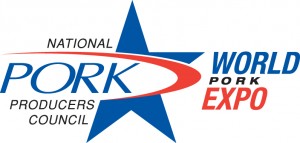By Dick Hagen, of Hagen and Associates
Perhaps speaking for the 400+ exhibitors at the 2012 World Pork Expo, Des Moines, John Baumgartner, President, Baumgartner Environics, Inc., Olivia, MN simply said, “Expo is the one-stop place for scientific and business information technology for the pork industry. And to a huge extent, this show is about people. Be that pork producers renewing acquaintances, technical people briefing on the latest issues and new products, and enjoying the atmosphere of international guests from everywhere. Expo truly is the celebration of the U.S. Pork industry and we were hugely satisfied and impressed with the traffic at our EPI-Air exhibit.”
Show-stealer for BEI was their unique display of the EPI (Electrostatic Particle Ionization) system in which participants slapped on a wrist band and decidedly felt the ‘tingle’ of electronic waves which capture airborne dust, ammonia, odor and hydrogen sulfide within hog production buildings. The net result of this ionization process is cleaner air or ‘EPI-Air’ which in turn results in faster gains, reduced mortalities, and slight improvements in feed efficiencies.
Commented Matt Baumgartner, general manager of BEI, “We first released the Murphy-Brown test data validating our EPI technology at the 2011 Expo. Since that time there has been quite a bit of industry talk about this data and our technology, precipitated because Murphy-Brown, North America’s largest hog producer, is now installing EPI units throughout their Western Division.”
 “We had 7, sometimes 8 of our own people at our Expo booth and often just simply couldn’t keep up with the questions and inquiries. That’s about as good as it gets. Expo literally was a home run for us, with the bases loaded.”
“We had 7, sometimes 8 of our own people at our Expo booth and often just simply couldn’t keep up with the questions and inquiries. That’s about as good as it gets. Expo literally was a home run for us, with the bases loaded.”
Dr. Gary Bradley, Research Coordinator, Murphy-Brown LLC, directed the trials of the EPI technology. Interviewed at the Pork Expo, he commented, “We were fortunate to be on the ground floor of this new technology. We were quite impressed with the performance results and thus our major move with the installation of EPI units in most of our nursery facilities.”
We were fortunate to be on the ground floor of this new technology. We were quite impressed with the performance results and thus our major move with the installation of EPI units in most of our nursery facilities.
Next move for Murphy-Brown is testing EPI units in growing/finishing facilities. “There are different dynamics with ventilation in larger barns. Humidity may be more of a factor relating to the efficacy of ionization of air in larger barns. So our work now relates to the impact of negative ions in a more humid environment,” says Bradley.
Could EPI technology possibly reduce the movement of PRRS virus? Bradley only ventured, “That might be a possibility. I don’t think the negative ions could eliminate the virus from the barn. However, combined with the overhead positioning of EPI units perhaps a portable unit used at floor level could be ‘zapping’ viruses after the wash down.”
He speculates there likely will be additional technology that branches off from the current EPI system. As a research scientist he’s more than willing and ready to further explore new ideas. “Preliminary results were phenomenal in our nursery units so we’re totally open to stretching our minds about a further spin off of EPI technology.”

